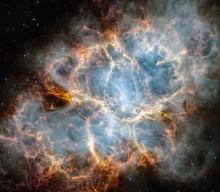Listen to today's episode of StarDate on the web the same day it airs in high-quality streaming audio without any extra ads or announcements. Choose a $8 one-month pass, or listen every day for a year for just $30.
You are here
Pulsars II
Those are the sounds of the undead — radio waves from the corpses of once-mighty stars. They’re known as pulsars, because they emit pulses of energy as they spin — from about one turn per second to hundreds of turns.
A massive star ends its life with a bang — it explodes as a supernova. The star’s outer layers are blasted into space, while its core is crushed to form an ultra-dense ball known as a neutron star. It’s up to a couple of times the mass of the Sun, but only as wide as a small city. It’s so dense that a teaspoonful of its material would weigh as much as tens of millions of elephants.
The core’s collapse concentrates its original magnetic field into a tiny volume, so the neutron star is highly magnetized. Charged particles caught in the magnetic field emit energy, most often in the form of radio waves, which is beamed out into space.
The neutron star also spins fast, so the beams of energy rotate like a lighthouse beacon. If one of those beams happens to sweep past Earth, then radio telescopes see the neutron star blink on and off — it pulses, so it’s known as a pulsar.
The fastest pulsars “steal” gas from a companion star. As the gas crashes onto the neutron star, the star spins faster — up to hundreds of times per second. So recordings of the radio waves from these stars sound like electric blenders, whipping up the space around them. More about that tomorrow.
Script by Damond Benningfield





